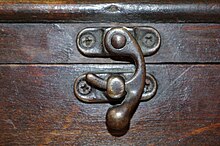Hook closure
A hook fastener is a complementary device made of hook and eye to fix at least two sides and to be able to detach them again.
history
Simple hook fastenings on necklaces and bracelets were already known in the Bronze Age. In clothing, hook fastenings were the forerunners of the zip .
use
When closing, the hook - depending on the version - is rotated or hooked into the eye.
Types of hook clasps
Sticking
Since hook fasteners take up less space than zippers and are easier to open and close than buttons , they are particularly used in underwear. Most of the brassiere nowadays are closed with so-called adhesive tape . Check marks are also typically used for negligés (provided they can be opened), mostly because buttons are not very " sexy " ( a hindrance for lingerie and nightwear ). If the fastener is in the neck area, ticks are easier to open, because buttonholes may be difficult to see due to the restricted field of view of the neck. However, the holder can be a disadvantage because thin hooks loosen more easily than buttons. If possible, an additional holding device is advisable (e.g. straps). Even with older bodysuits in particular , the fastener consists of hooks (nowadays, however, press studs are more used ).
Trouser hooks
In Men's pants (especially in Trousers ) is trouser button often combined with a trouser hooks, in order to increase the strength of the closure. To do this, the trouser hook is first hooked into the eyelet and then the clasp is fixed with a button to secure the clasp.
Jewelry clasps
As in the Bronze Age, hook clasps are still used today for bracelets, chains and various other jewelry items. The spectrum ranges from the simple Bronze Age hook closure to the S-hook closure to unusual hook-and-eye compositions.
Container closures
For chests , caskets , boxes and similar containers, hooks and eyes are usually designed to be more massive, since they are exposed to greater loads than hook fasteners in items of clothing. Since they do not connect elastic fabrics, but two parts made of solid material - lid and body - the hook is usually screwed into the eye with this type of closure. There is a handle on the hook to make opening and closing easier.
Individual evidence
- ↑ The Nordic Middle Bronze Age (around 1200–1100 BC). In: archaeologie-welt.blogspot.de. Retrieved September 19, 2016 .
- ↑ The older Bronze Age in western Brandenburg (around 1500–1200 BC). In: archaeologie-welt.blogspot.de. Retrieved September 19, 2016 .


